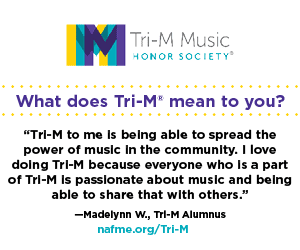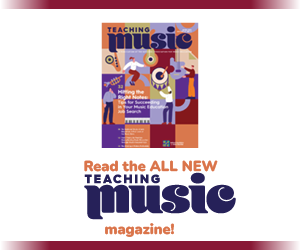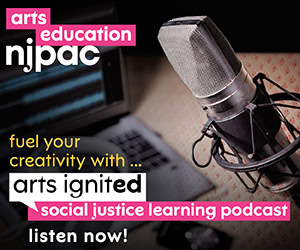/ News Posts / Repertoire Selection Is Key in a Virtual World
Repertoire Selection Is Key in a Virtual World
Four Key Elements to Consider
By NAfME Member Steve Martin, sponsored by GPG Music
For nearly a year we’ve shifted from traditional in-person learning of music to running a similar process virtually. During that time, we’ve realized that performing arts educators who are trying to achieve the same results from previous years require a bit of a paradigm shift. We are realizing that how educators teach and how students learn are different processes when learning ensemble music and working towards a virtual performance.

iStockphoto.com | Earl Manus
One of the key components in the success of an Our Virtual Ensemble (OVE) project powered by GPG Music is considering several key characteristics when choosing repertoire. This is especially important when embarking on your first project, as it will help students stay closer to their comfort zones and promote a higher level of achievement in both the process and the final product.
Be mindful of these key elements when selecting your piece for virtual learning and performance:
Favor a moderate tempo:
Pieces that are too fast or too slow can present challenges to performers when recording to a click track. It’s best to stay in the range of 88 to 144 beats per minute.
A consistent tempo throughout:
While this is not a deal-breaker, it is certainly more challenging for performers to record videos to a click track containing accelerandos, retardandos, fermatas, and/or tempo changes.
Appropriate difficulty level:
We advise selecting literature slightly less demanding than your ensemble is accustomed to. This becomes less of a factor as the performers are involved in subsequent projects, but it can be a barrier to success when performers are still adjusting to the modified learning and recording process.
Strengths and weaknesses of your ensemble:
The area(s) where your ensemble is less proficient can be amplified and exaggerated in the virtual ensemble environment. Think of it this way—this is like putting a microphone next to every single performer in your ensemble. Carefully review your desired selections to be sure you’re setting your performers up for the maximum level of achievement and not risk exposing areas of weakness.

iStockphoto.com | Earl Manus
Finally, and maybe most importantly, take the time to select a piece that allows your ensemble to shine and promote a sense of accomplishment among your performers. We would all love to be performing in person together again, but until then, let’s make music together virtually and have fun doing it! The OVE team is happy to work with educators to select pre-licensed music from GPG Music or to utilize other licensed works.
About the author:
 Steve Martin, DMA, (ASCAP) is the owner/CEO of GPG Music and founder of Our Virtual Ensemble, a conductor, composer, and trumpet player. Dr. Martin began his career as a high school band director and currently works as a designer and composer for numerous high school and university programs across the United States. As a composer, he has written commissions, arrangements, and drill for nationally acclaimed and award-winning bands for nearly 25 years across a wide variety of genres. In 2004, he premiered his first concert band work High Regard. In 2005, he composed and produced the musical score for the full-length, independent motion picture Compadres. Steve is a founding member and Associate Conductor of the Reno Wind Symphony; a member of the College Band Directors National Association, National Association for Music Education, Kappa Kappa Psi, Phi Mu Alpha Sinfonia, and an associate member of the American Bandmasters Association. GPG Music is NAfME corporate member.
Steve Martin, DMA, (ASCAP) is the owner/CEO of GPG Music and founder of Our Virtual Ensemble, a conductor, composer, and trumpet player. Dr. Martin began his career as a high school band director and currently works as a designer and composer for numerous high school and university programs across the United States. As a composer, he has written commissions, arrangements, and drill for nationally acclaimed and award-winning bands for nearly 25 years across a wide variety of genres. In 2004, he premiered his first concert band work High Regard. In 2005, he composed and produced the musical score for the full-length, independent motion picture Compadres. Steve is a founding member and Associate Conductor of the Reno Wind Symphony; a member of the College Band Directors National Association, National Association for Music Education, Kappa Kappa Psi, Phi Mu Alpha Sinfonia, and an associate member of the American Bandmasters Association. GPG Music is NAfME corporate member.
Did this blog spur new ideas for your music program? Share them on Amplify! Interested in reprinting this article? Please review the reprint guidelines.
The National Association for Music Education (NAfME) provides a number of forums for the sharing of information and opinion, including blogs and postings on our website, articles and columns in our magazines and journals, and postings to our Amplify member portal. Unless specifically noted, the views expressed in these media do not necessarily represent the policy or views of the Association, its officers, or its employees.
February 15, 2021. © National Association for Music Education (NAfME.org)
Published Date
February 15, 2021
Category
- Ensembles
- Innovation
- Repertoire
- Technology
Copyright
February 15, 2021. © National Association for Music Education (NAfME.org)




